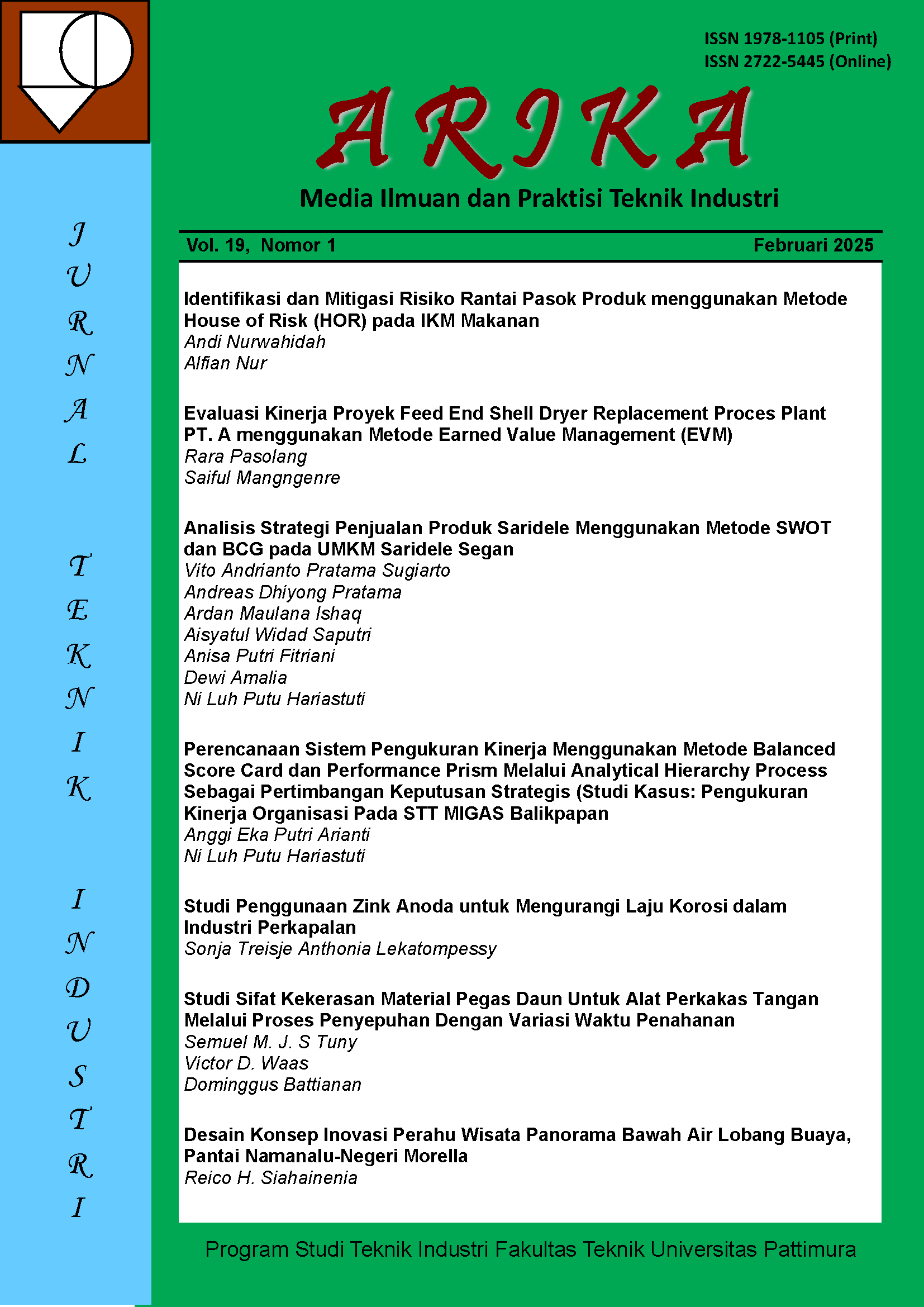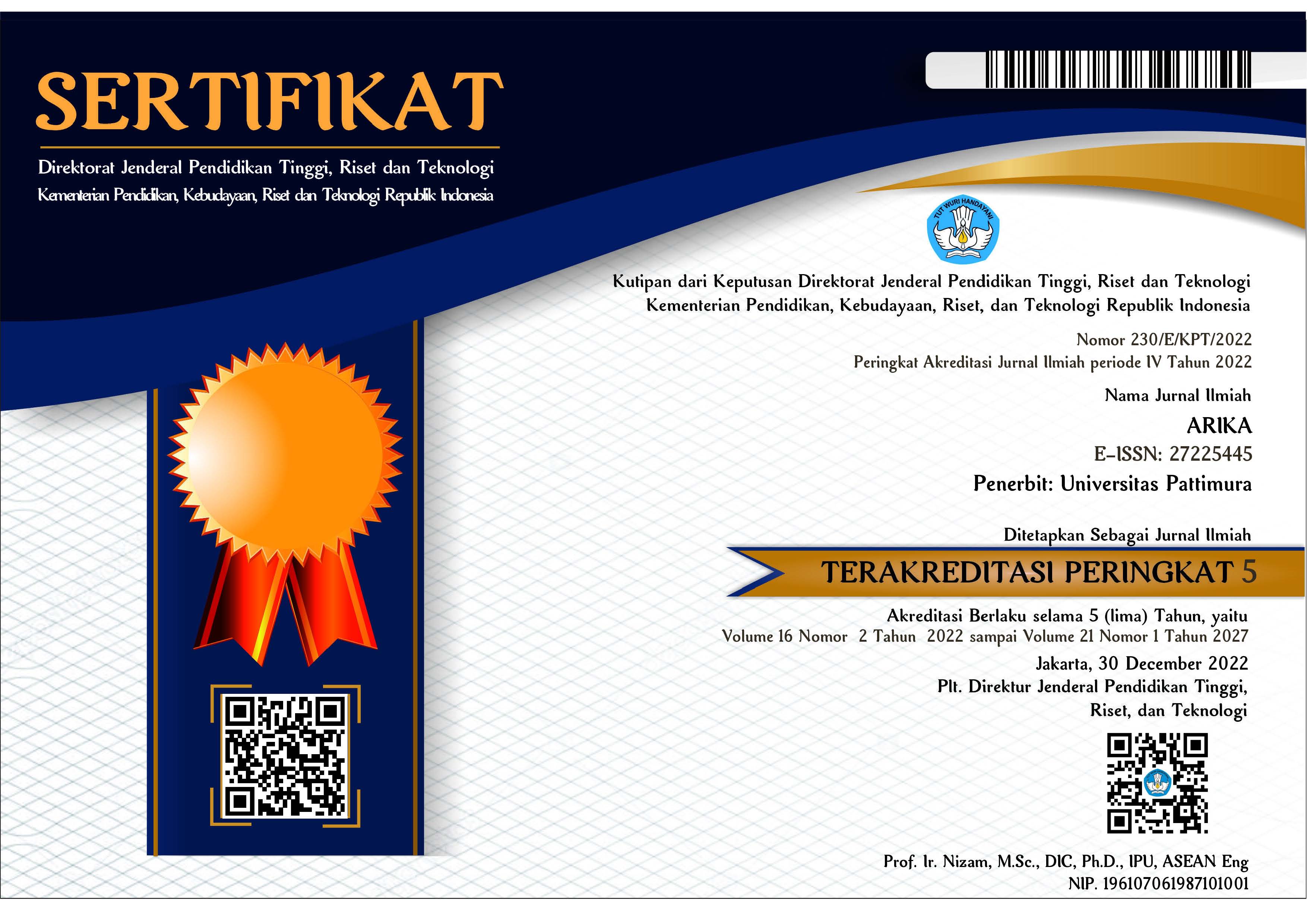Studi Penggunaan Zink Anoda untuk Mengurangi Laju Korosi dalam Industri Perkapalan
Study of the Use of Zinc Anodes to Reduce Corrosion Rate in the Shipping Industry
Abstract
One way to reduce the rate of corrosion on ships is to use zinc anodes. The weight of the zinc anode plays an important role in determining how much zinc anode must be installed on the wet surface of the ship to withstand the rate of corrosion. This study aims to obtain protection against corrosion rates by analyzing data on the use of zinc anodes in the field and data on the use of zinc anodes from calculations. To determine the ability of the installed zinc anode, data on the last 5 years of corrosion rates from 3 ships and the amount of zinc anodes used each year are needed. The results obtained show that there was no addition of zinc anodes on ship 1 in the 4th year to the 5th year of 64,046 kg, the highest corrosion rate reached 0.1708 mm/year, while on ship 2, with the addition of zinc anode weight of 25,704 kg the corrosion rate decreased in the 5th year to 0.0317 mm/year. On ship 3 in the 4th year with the addition of zinc anode weight of 45,868 kg the corrosion rate decreased to 0.0138 mm/year.
Downloads
References
Chahar, B. S., Singh, V., Bhadu, M. K., Hadas , S., ZBhagat, A. N., Mondal, K., (2024). Recovery and utilization of zinc dross for sacrificial anode chatodic protection of steel structures Elsevier 41 https://doi.org/10.1016/j.susmat.2024.e01046
Farroq, A, Hamza, M., Ahmed, Qadeer,. Deen, K. M. (2019). Evaluating the performance of zinc and aluminium sacrificial anodes in artificial seawater Elsevier 314 135-141 https://doi.org/10.1016/j.electacta.2019.05.067.
Imran, M. H., Khan, M. I., Jamaludin, S., Hasan, I., Ahmad, M. F. B., Ayob, A. F. M., Nik, W. M. N. B. W., Suhrab, M. I. L., Zulkifli, M. F. R. B., Afrizal, M. B., Ahmad, S. Z. A. B. S., (2024). A critical analysis of machine learning in ship , offshore, and oil & gas corrosion research , part I: corrosion detection and classification Elsevier 313 https://doi.org/10.1016/j.oceaneng.2024.119600
Kusumaningrum, I., Usman, M. (2019). The effect of more anodic metals from zinc addition on cathodic protection of iron with zinc as sacrificial anode againts AIP Conf. 494 https://doi.org/10.1088/1757-899X/494/1/012086
Lekatompessy, S. T. A. (2023). The wear rate of zinc anode on surface underwater of ships in reducing corrosion rate AIP Conf. Proc. AIP Publishing 2588 , https://doi.org/10.1063/5.0111844
Lekatompessy, S. T. A., Latuhihin, G. R. (2021). Analysis of the effect of protection system installation cathode and sacrificial anode (Zn) on corrosion rate of steel vessels AIP Conf. Proc. 2360 https://doi.org/10.1063/5.0059554
Mahendra, T. I., Dwisetiono. (2022). Cathodic protection using xinc anode to inhibiti corrosion on the hull of ship port link VII Jakarta 3 56-62 https://doi.org/10.36761/hexagon.v3i1.1492
Muh, S., Juswan, S., Paroka, P. (2024). Analysis of needs and placement of zinc anode for new ferry ship buildings Maritime Park Journal of Maritime Technology and Society 3 44-45 https://doi.org/10.62012/mp.v3i2.35389
Trethewey, K. R. (1993). Corrosion for Students of Science and Engineering Longman Scientific and Technical.
Tubaro, E., Fabro L. D., Pesle, M., Bontempi, A., Fedrizzi, L., Andreatta, F. (2025). Effect of zinc anodes on the behavior of antifouling coatings applied on copper alloys Elsevier 201 https://doi.org/10.1016/j.porgcoat.2025.109153.
Xu, L., Xin, Y., Ma, Li., Zhang, H., Lin, Z., Li, X., (2021). Challenges and solutions of cathodic protection for marine ship Elsevier 2 33-40 https://doi.org/10.1016/j.corcom.2021.08.003.
Copyright (c) 2025 Sonja Treisje Anthonia Lekatompessy

This work is licensed under a Creative Commons Attribution-ShareAlike 4.0 International License.
An author who publishes in the ARIKA Jurnal agrees to the following terms:
- The author retains the copyright and grants ARIKA journal the right of first publication of the work simultaneously licensed under the Creative Commons Attribution-ShareAlike 4.0 License that allows others to share the work with an acknowledgment of the work's authorship and initial publication in this journal.
- The author is able to enter into separate, additional contractual arrangements for the non-exclusive distribution of the journal's published version of the work (e.g., post it to an institutional repository or publish it in a book) with the acknowledgment of its initial publication in this journal.
- The author is permitted and encouraged to post his/her work online (e.g., in institutional repositories or on their website) prior to and during the submission process, as it can lead to productive exchanges, as well as earlier and greater citation of the published work (See The Effect of Open Access).










